The Outcome Primers Series 2.0
The OUTCOME Primer: Envisioning Learning Outcomes
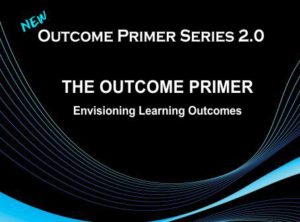 In curriculum development, nothing is more important than beginning with robust learning outcomes – everything else depends on it. This primer does three things for you: 1) puts the whole outcomes and assessment initiative in the context of 21st century thought; 2) enables you to distinguish good from bad outcome statements; and 3) provides you with a step-by-step guide for facilitating work sessions in which instructors and stakeholders together build clear, concise learning outcomes that are relevant to real-life roles. (Table of Contents)
In curriculum development, nothing is more important than beginning with robust learning outcomes – everything else depends on it. This primer does three things for you: 1) puts the whole outcomes and assessment initiative in the context of 21st century thought; 2) enables you to distinguish good from bad outcome statements; and 3) provides you with a step-by-step guide for facilitating work sessions in which instructors and stakeholders together build clear, concise learning outcomes that are relevant to real-life roles. (Table of Contents)
The ASSESSMENT Primer: Assessing and Tracking Evidence of Learning Outcomes
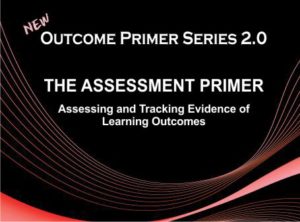 Learning assessment, which takes on multiple meanings in an outcome-based system, is no longer a simple thing. It requires skills in developing work quality assessment tasks, quality criteria, and new assessment tools. It means creating a multi-level system for gathering, tracking, analyzing, reporting, and using evidence of learning to improve what we do. This primer excels in making the complex process of assessment both practical and as simple as possible, but no simpler. (Table of Contents)
Learning assessment, which takes on multiple meanings in an outcome-based system, is no longer a simple thing. It requires skills in developing work quality assessment tasks, quality criteria, and new assessment tools. It means creating a multi-level system for gathering, tracking, analyzing, reporting, and using evidence of learning to improve what we do. This primer excels in making the complex process of assessment both practical and as simple as possible, but no simpler. (Table of Contents)
The CONTENT Primer: Aligning Essential Content with Learning Outcomes
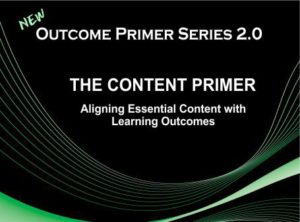 In a 21st century world, textbooks shouldn’t govern content; outcomes should govern content. Deciding what content needs to be learned in any course or program today is a seemingly backward process: beginning with the outcome before determining content. This primer provides instructors and curriculum leaders with four key things: 1) a 21st century understanding of learning and content; 2) instructions for facilitating a work session on aligning content with intended outcomes; 3) a concise way to organize content that is based on how learning occurs; and 4) many examples of course and program outcome guides. (Table of Content)
In a 21st century world, textbooks shouldn’t govern content; outcomes should govern content. Deciding what content needs to be learned in any course or program today is a seemingly backward process: beginning with the outcome before determining content. This primer provides instructors and curriculum leaders with four key things: 1) a 21st century understanding of learning and content; 2) instructions for facilitating a work session on aligning content with intended outcomes; 3) a concise way to organize content that is based on how learning occurs; and 4) many examples of course and program outcome guides. (Table of Content)
The MAPPING Primer: Mapping the Way to Learning Outcomes
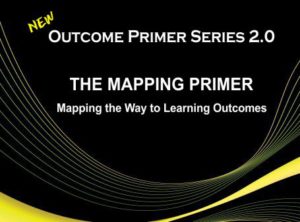 Do we have to draw them a picture? Yes, why not? Instead of giving students just a list of courses, why shouldn’t we construct a map that shows them the journey through an academic program: how the courses are related; where there are options; where the major assessments will be made; how each course aligns with the program outcomes; where there are opportunities to integrate what is learned. While a program map is helpful to learners, the real value is having faculty come together around one big sheet of paper to construct and then see (perhaps for the first time) how courses connect and relate (or not) to the stated outcomes. The mapping processes detailed in this Primer will do more to engage faculty in serious dialogue than anything else you have ever tried. (Table of Contents)
Do we have to draw them a picture? Yes, why not? Instead of giving students just a list of courses, why shouldn’t we construct a map that shows them the journey through an academic program: how the courses are related; where there are options; where the major assessments will be made; how each course aligns with the program outcomes; where there are opportunities to integrate what is learned. While a program map is helpful to learners, the real value is having faculty come together around one big sheet of paper to construct and then see (perhaps for the first time) how courses connect and relate (or not) to the stated outcomes. The mapping processes detailed in this Primer will do more to engage faculty in serious dialogue than anything else you have ever tried. (Table of Contents)
The GUIDING Primer: Guiding Toward Learning Outcomes
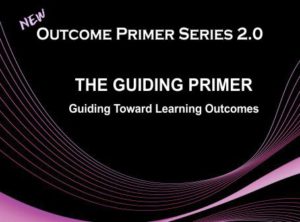 This Primer takes you beyond the old-school perception of what it means to “teach” to what it means to “guide” learners to intended outcomes. It is primarily designed for instructors who are looking to improve the quality and effectiveness of classroom and on-line learning. We introduce eight essential guiding practices through the eyes of an experienced white-water river guide on a unique in-service day for a group of college faculty. We follow the faculty as they integrate these eight practices into an Alternative Energy Program shared by a university and a community college. (Table of Contents)
This Primer takes you beyond the old-school perception of what it means to “teach” to what it means to “guide” learners to intended outcomes. It is primarily designed for instructors who are looking to improve the quality and effectiveness of classroom and on-line learning. We introduce eight essential guiding practices through the eyes of an experienced white-water river guide on a unique in-service day for a group of college faculty. We follow the faculty as they integrate these eight practices into an Alternative Energy Program shared by a university and a community college. (Table of Contents)
The SUSTAINABILITY Primer: Sustaining Learning Outcomes and Assessment
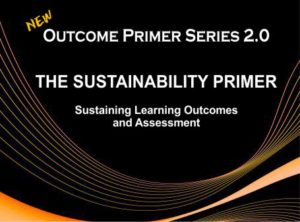 How do colleges sustain their work on outcomes and assessment over time? ( Many don’t! )
How do colleges sustain their work on outcomes and assessment over time? ( Many don’t! )
This Primer focuses on how a college can sustain an Outcomes and Assessment System by focusing on leadership, instructor involvement, professional development, and system integration. The book contains a series of tools for assessing the sustainability at four different levels of the college: organization-wide, program, multi-sectioned course, and instructor. (Table of contents)

